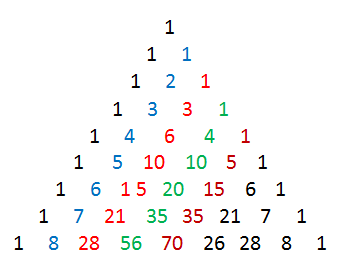7 Amazing Facts About Pascal’s Triangle
Pascal’s Triangle is a triangular array of numbers where each number on the “interior” of the triangle is the sum of the two numbers directly above it. It was named after French mathematician Blaise Pascal.
There are many interesting things about the Pascal’s triangle. In this post, we explore seven of these properties.
1. The numbers on each row are binomial coefficients.
The number on each row of the Pascal’s triangle are numbers of the expansion . For example, the numbers on the fourth row are
. These are the numbers in the expansion of
.
2. The numbers on the second diagonal form counting numbers.
3. The numbers on the third diagonal are triangular numbers.
4. The numbers on the fourth diagonal are tetrahedral numbers.
5. The numbers on the fifth diagonal are pentatope numbers.
6. The sum of the numbers on each row are powers of 2.
The sum of the first four rows are 1, 2, 4, 8, and 16. These numbers are and
7. A series of diagonals form the Fibonacci Sequence.
Aside from these interesting properties, Pascal’s triangle has many interesting applications. You may want to check out my posts on Milkshakes, Beads, and Pascal’s Triangle and the Binomial Expansion to know more about Pascal’s Triangle.
***
Image Credit: Wikipedia (GNU License)


